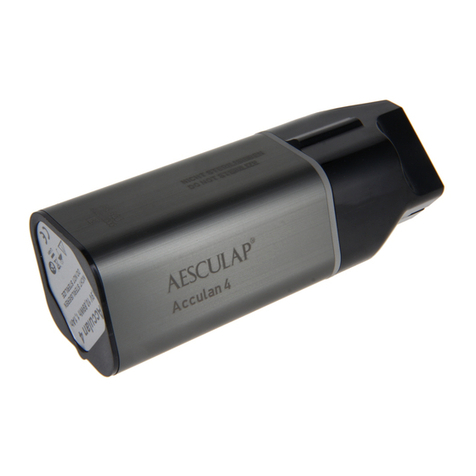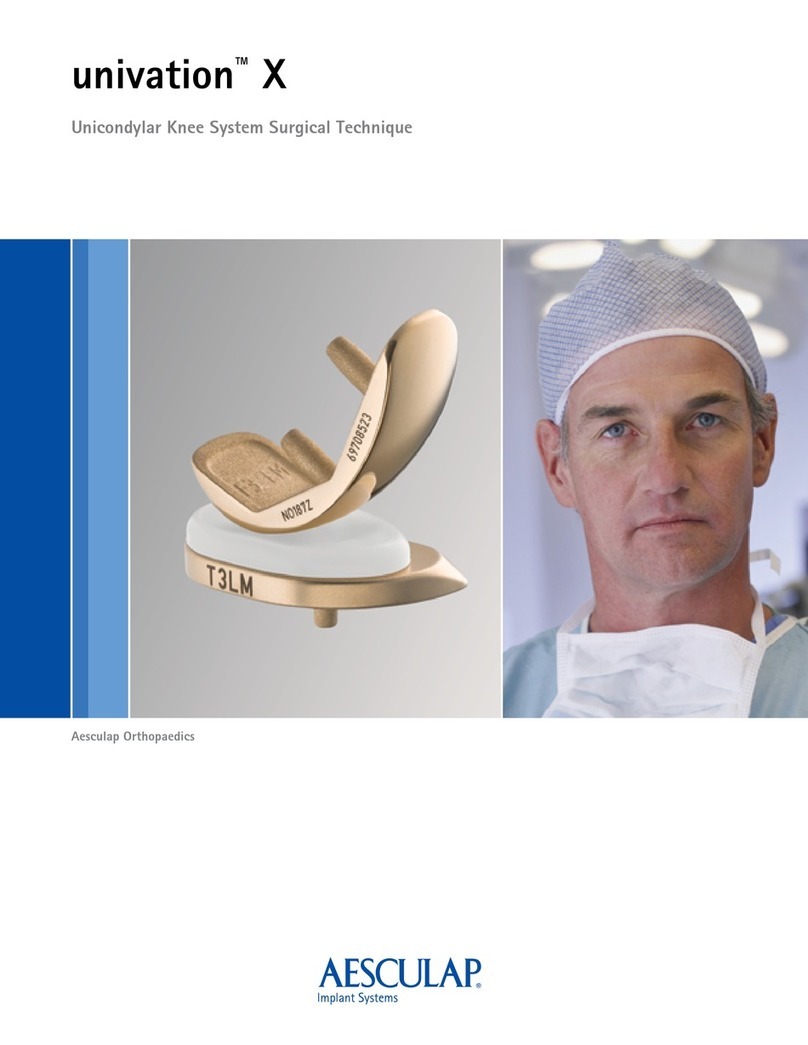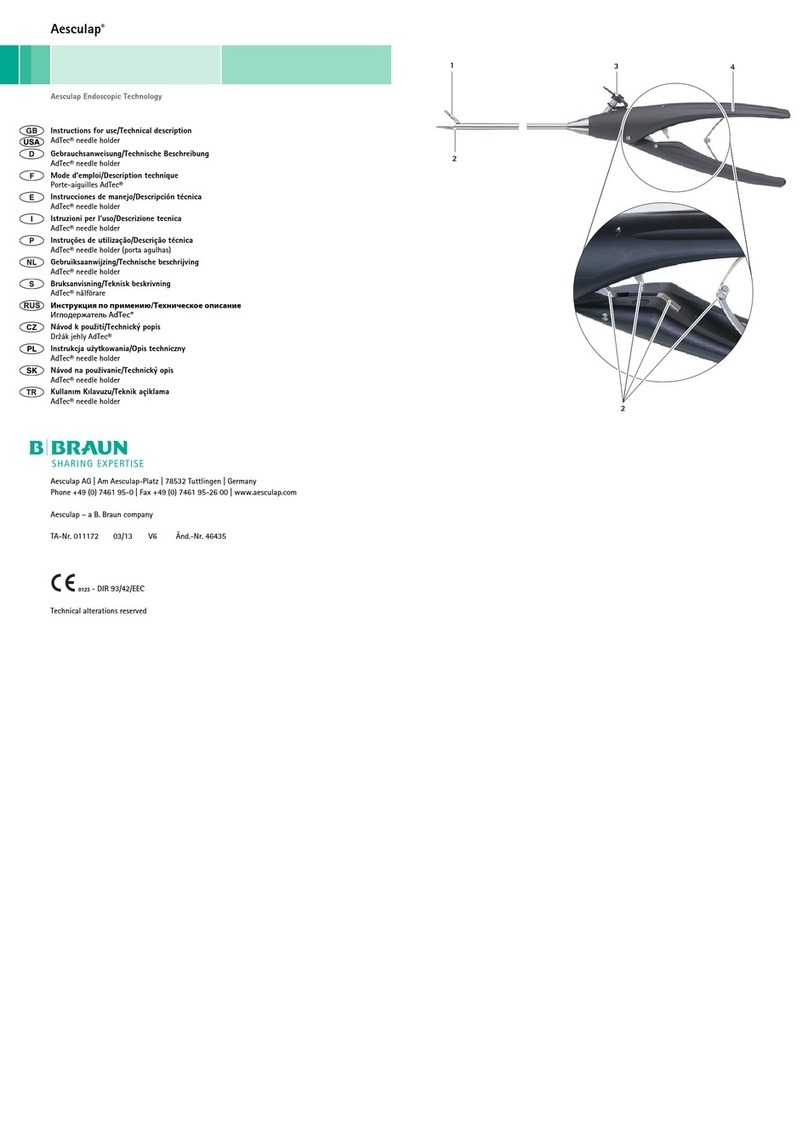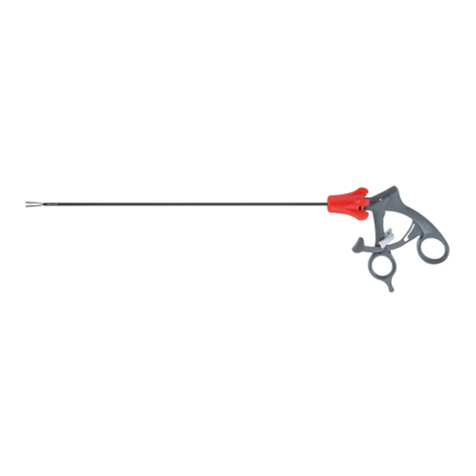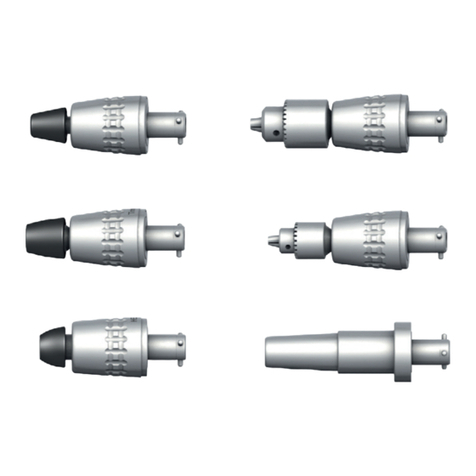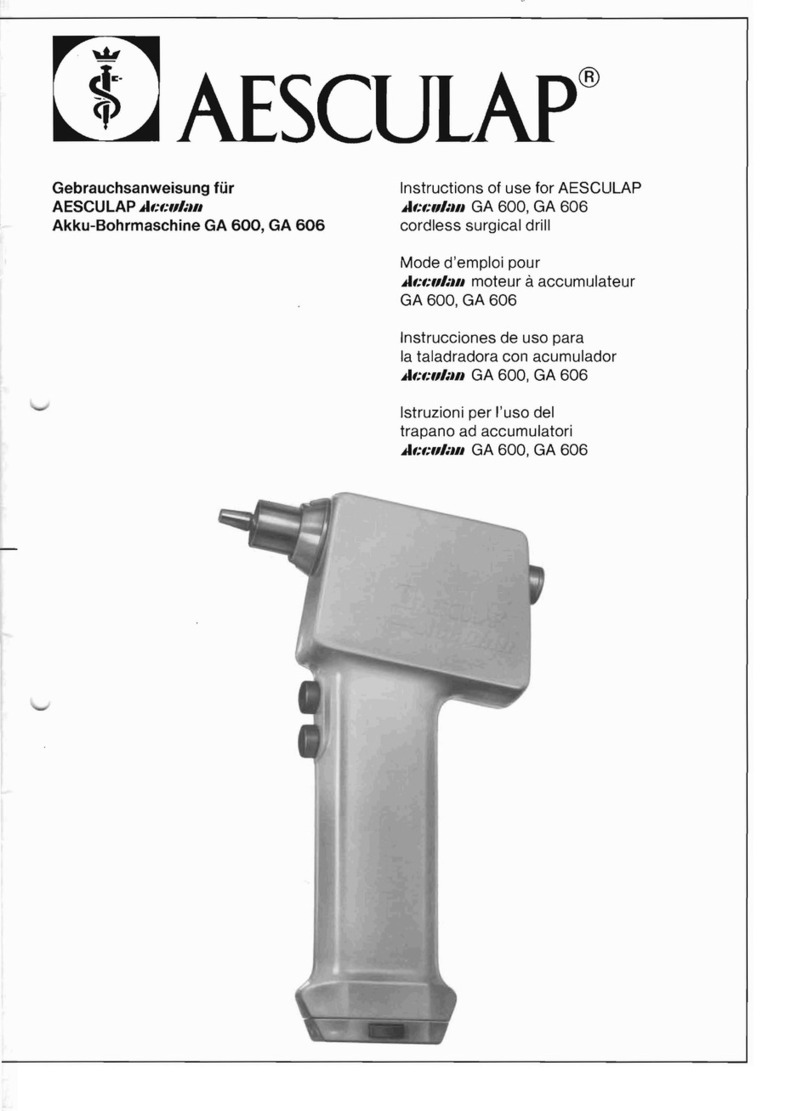Aesculap Acculan 4 Manual

Aesculap® Acculan 4
Aesculap Power Systems
en Instructions for use/Technical description
Reciprocating saw GA334
USA Note for U.S. users
This Instructions for Use is NOT intended for United States users. Please
discard. The Instructions for Use for United States users can be obtained
by visiting our website at www.aesculapusa.com. If you wish to obtain a
paper copy of the Instructions for Use, you may request one by contacting
your local Aesculap representative or Aesculap's customer service at 1-
800-282-9000. A paper copy will be provided to you upon request at no
additional cost.
de Gebrauchsanweisung/Technische Beschreibung
Stichsäge GA334
fr Mode d’emploi/Description technique
Scie sauteuse GA334
es Instrucciones de manejo/Descripción técnica
Sierra de punta GA334
it Istruzioni per l’uso/Descrizione tecnica
Sega coltellare GA334
pt Instruções de utilização/Descrição técnica
Serra pendular GA334
nl Gebruiksaanwijzing/Technische beschrijving
Steekzaag GA334
sv Bruksanvisning/Teknisk beskrivning
Sticksåg GA334
et Kasutusjuhend/Tehniline kirjeldus
Tikksaag GA334
ru Инструкция по примению/Техническое описание
Реципрокная пила GA334
cs Návod k použití/Technický popis
Přímočará pila GA334
pl Instrukcja użytkowania/Opis techniczny
Piła posuwisto - zwrotna GA334
sk Návod na použitie/Technický opis
Priamočiara píla GA334
tr Kullanım Kılavuzu/Teknik açiklama
Oyma testeresi GA334

18 16
19 20
21
11
14
22
23
1
13
17
8
9
4
5
12
15
7

BC
6
4
1
10
4
1
22
14
A
D
7

2
en
Aesculap® Acculan 4
Reciprocating saw GA334
Legend
1Product (reciprocating saw)
2Trigger (for oscillation frequency control)
3Safety catch
4Battery bay
5Locking pin
6Sterile funnel
7Battery
8Lid
9Lid release element
10 Battery removal device
11 Saw blade
12 Rotating sleeve
13 Cut-outs (for centering sleeve)
14 Saw blade coupling
15 Cleaning template
16 Support foot
17 Rinsing adapter
18 Opening (at support foot)
19 Marking (at support foot)
20 Locking sleeve (to couple the support foot)
21 Centering pins
22 Inspection hole (for the bottom of the slot of the saw blade coupling)
The depictions are schematic only.
Symbols on product and packages
Caution
Observe important safety information such as warnings
and precautions in the instructions for use.
YYYY-MM
Maintenance label
Indication of the next maintenance appointment (Date:
Year-Month)
Two-dimensional machine readable code
The code contains a unique serial number that can be
used for electronically tracking single instruments. The
serial number is based on the worldwide standard sGTIN
(GS1).
Manufacturer
Date of manufacture
Follow the instructions for use
Labeling of electrical and electronic devices pursuant to
directive 2002/96/EG (WEEE)
Classification Type BF
Manufacturer’s batch designation
Manufacturer serial number
Manufacturer order number
Temperature limits during transport and storage
Air humidity limits during transport and storage
Atmospheric pressure limits during transport and stor-
age
Operating mode
According to US federal law, this product may only be
sold by a physician or by the order of a physician
CE mark according to Regulation (EU) 2017/745
Medical device
Oscillation frequency control
Locking sleeve open/closed
S9

3
en
Contents
1. About this document. . . . . . . . . . . . . . . . . . . . . . . . . . . . . . . . . . 3
1.1 Scope . . . . . . . . . . . . . . . . . . . . . . . . . . . . . . . . . . . . . . . . . . . . . . 3
1.2 Warnings . . . . . . . . . . . . . . . . . . . . . . . . . . . . . . . . . . . . . . . . . . . 3
2. General information . . . . . . . . . . . . . . . . . . . . . . . . . . . . . . . . . . 3
2.1 Intended use. . . . . . . . . . . . . . . . . . . . . . . . . . . . . . . . . . . . . . . . . 3
2.2 Main functions and design characteristics . . . . . . . . . . . . . . . . 3
2.2.1 Operating mode . . . . . . . . . . . . . . . . . . . . . . . . . . . . . . . . . . . . . . 3
2.3 Indications . . . . . . . . . . . . . . . . . . . . . . . . . . . . . . . . . . . . . . . . . . 4
2.4 Absolute contraindications . . . . . . . . . . . . . . . . . . . . . . . . . . . . . 4
2.5 Relative contraindications . . . . . . . . . . . . . . . . . . . . . . . . . . . . . 4
3. Safe handling . . . . . . . . . . . . . . . . . . . . . . . . . . . . . . . . . . . . . . . . 4
4. Product description . . . . . . . . . . . . . . . . . . . . . . . . . . . . . . . . . . . 4
4.1 Scope of supply . . . . . . . . . . . . . . . . . . . . . . . . . . . . . . . . . . . . . . 4
4.2 Components required for operation . . . . . . . . . . . . . . . . . . . . . . 4
4.3 Operating principle . . . . . . . . . . . . . . . . . . . . . . . . . . . . . . . . . . . 4
5. Preparation. . . . . . . . . . . . . . . . . . . . . . . . . . . . . . . . . . . . . . . . . . 4
6. Working with the device . . . . . . . . . . . . . . . . . . . . . . . . . . . . . . . 4
6.1 System set-up . . . . . . . . . . . . . . . . . . . . . . . . . . . . . . . . . . . . . . . 5
6.1.1 Connecting the accessories. . . . . . . . . . . . . . . . . . . . . . . . . . . . . 5
6.1.2 Inserting the rechargeable battery. . . . . . . . . . . . . . . . . . . . . . . 5
6.1.3 Intraoperative battery change . . . . . . . . . . . . . . . . . . . . . . . . . . 5
6.1.4 Removing the rechargeable battery. . . . . . . . . . . . . . . . . . . . . . 5
6.1.5 Protection against inadvertent activation. . . . . . . . . . . . . . . . . 5
6.1.6 Attaching and detaching the saw blade . . . . . . . . . . . . . . . . . . 6
6.2 Function checks . . . . . . . . . . . . . . . . . . . . . . . . . . . . . . . . . . . . . . 6
6.3 Safe operation . . . . . . . . . . . . . . . . . . . . . . . . . . . . . . . . . . . . . . . 6
6.3.1 Operating the product. . . . . . . . . . . . . . . . . . . . . . . . . . . . . . . . . 6
7. Validated reprocessing procedure . . . . . . . . . . . . . . . . . . . . . . . 7
7.1 General safety notes . . . . . . . . . . . . . . . . . . . . . . . . . . . . . . . . . . 7
7.2 General information . . . . . . . . . . . . . . . . . . . . . . . . . . . . . . . . . . 7
7.3 Reusable products . . . . . . . . . . . . . . . . . . . . . . . . . . . . . . . . . . . . 7
7.4 Preparations at the place of use. . . . . . . . . . . . . . . . . . . . . . . . . 7
7.5 Preparation before cleaning . . . . . . . . . . . . . . . . . . . . . . . . . . . . 7
7.6 Product-specific safety instructions for the processing
procedure . . . . . . . . . . . . . . . . . . . . . . . . . . . . . . . . . . . . . . . . . . . 7
7.7 Manual cleaning with wipe disinfection . . . . . . . . . . . . . . . . . . 8
7.8 Automatic cleaning/disinfection with manual pre-cleaning . . 9
7.8.1 Manual pre-cleaning with a brush. . . . . . . . . . . . . . . . . . . . . . . 9
7.8.2 Mechanical alkaline cleaning and thermal disinfection. . . . . . 9
7.9 Inspection, maintenance and checks . . . . . . . . . . . . . . . . . . . . . 10
7.10 Packaging . . . . . . . . . . . . . . . . . . . . . . . . . . . . . . . . . . . . . . . . . . . 10
7.11 Steam sterilization. . . . . . . . . . . . . . . . . . . . . . . . . . . . . . . . . . . . 10
7.12 Storage . . . . . . . . . . . . . . . . . . . . . . . . . . . . . . . . . . . . . . . . . . . . . 10
8. Maintenance . . . . . . . . . . . . . . . . . . . . . . . . . . . . . . . . . . . . . . . . 10
9. Troubleshooting list. . . . . . . . . . . . . . . . . . . . . . . . . . . . . . . . . . . 11
10. Technical Service . . . . . . . . . . . . . . . . . . . . . . . . . . . . . . . . . . . . . 12
11. Accessories/Spare parts. . . . . . . . . . . . . . . . . . . . . . . . . . . . . . . . 13
12. Technical data . . . . . . . . . . . . . . . . . . . . . . . . . . . . . . . . . . . . . . . 13
12.1 Classification according to Regulation (EU) 2017/745. . . . . . . 13
12.2 Performance data, information about standards . . . . . . . . . . . 13
12.3 Nominal operating mode . . . . . . . . . . . . . . . . . . . . . . . . . . . . . . 13
12.4 Ambient conditions . . . . . . . . . . . . . . . . . . . . . . . . . . . . . . . . . . . 13
13. Disposal . . . . . . . . . . . . . . . . . . . . . . . . . . . . . . . . . . . . . . . . . . . . 13
1. About this document
1.1 Scope
These instructions for use apply to the products listed below:
►For instructions for use of specific items and information on material
compatibility, see B. Braun eIFU at eifu.bbraun.com
1.2 Warnings
Warnings indicate risks to patients, users, and/or the product that could
develop while using the product. Warnings are marked as follows:
DANGER
Indicates a potential danger. If it is not prevented, death or severe
injuries may result.
WARNING
Indicates a potential danger. Minor or moderate injuries may result if
this is not prevented.
CAUTION
Indicates a potential damage to property. The product may become
damaged if it is not prevented.
2. General information
2.1 Intended use
Task/Function
When combined with the appropriate tool, and where required with the
corresponding protection guide, the Reciprocating saw GA334 is used to
work on hard tissue, cartilage and related materials, as well as bone
replacement materials.
Application Environment
The product fulfills the requirements for type BF pursuant to
IEC/DIN EN 60601-1 and is used in operating rooms in sterile environ-
ments of explosion risk areas (such as areas with pure oxygen or anesthe-
sia gases).
2.2 Main functions and design characteristics
2.2.1 Operating mode
Operation with non-periodic load and speed changes (type S9 pursuant to
IEC EN 60034-1)
■30 second application, 30 second pause
■5 repetitions
■30 min cooling time
■Max. Temperature 48 °C
Electrical systems generally heat up during continual operation. It is
advised to give the system a break after use to cool down, as listed in the
table on operating mode.
Heating depends on the tool used and the load. After a certain number of
repetitions, the system should cool down. This procedure prevents the sys-
tem overheating as well as possible injury to the patient or user.
The user is responsible for the use and adherence to the pause sequence
described.
Art. no. Name
GA334 Reciprocating saw
Oscillation frequency min. 0 rpm to max. 15 000 rpm
This manual suits for next models
1
Table of contents
Languages:
Other Aesculap Medical Equipment manuals
Popular Medical Equipment manuals by other brands

Getinge
Getinge Arjohuntleigh Nimbus 3 Professional Instructions for use

Mettler Electronics
Mettler Electronics Sonicator 730 Maintenance manual

Pressalit Care
Pressalit Care R1100 Mounting instruction

Denas MS
Denas MS DENAS-T operating manual

bort medical
bort medical ActiveColor quick guide

AccuVein
AccuVein AV400 user manual

